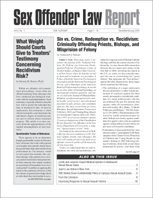From the Literature
Author: Alissa Ackerman.; Jaime V. Raba, J.D..; Dan Thomason.
Source: Volume 12, Number 05, August/September 2011 , pp.69-70(2)

< previous article |next article > |return to table of contents
Abstract:
This column summarizes a series of studies related to the shifting landscape of sex offender policy, with a particular emphasis on those analyzing the political dimensions. In a study on public support for the death penalty for sex offenders, Mancini and Mears find that a small majority of individuals in a 1991 poll supported such a policy (To Execute or Not to Execute? Examining Public Support for Capital Punishment of Sex Offenders by Christina Mancini and Daniel P. Mears 38 J. Crim. Just. [2010]). Next, Mancini et al. assess whether people with children are more likely to support residence restrictions for sex offenders, and find that this is in fact the case. Tewksbury and Jennings then address whether publicly supported registration and notification (SORN) influence the recidivism rate on two cohorts of released sex offenders, one pre- and another post-SORN policies (Assessing the Impact of Sex Offender Registration and Community Notification on Sex-Offending Trajectories by Richard Tewksbury and Wesley G. Jennings 37 Crim. Just. & Behav. [2010]). Next, Hipp and colleagues question whether released sex offenders are moving into areas of social disorganization, concluding that these offenders tend to concentrate in socially disadvantaged areas (Are Sex Offenders Moving Into Social Disorganization? Analyzing the Residential Mobility of California Parolees by John R. Hipp, Susan Turner, and Jesse Jannetta 47 J. Res. on Crime & Delinq. [2010]). Bandy then embarks on research related to notification policies and the motivation for community members to change their behaviors based on being notified about an offender living nearby (Measuring the Impact of Sex Offender Notification on Community Adoption of Protective Behaviors by Rachel Bandy 10 Criminology & Pub. Pol’y [2011]). Finally, Ackerman and her colleagues utilize a panel dataset, spanning over 30 years, to assess whether recent sex offense policies have decreased the rate at which rapes occur in the United States (Legislation Targeting Sex Offenders—Are Recent Policies Effective in Reducing Rape? by Alissa R. Ackerman, Meghan Sacks, and David F. Greenberg Just. Q.).Keywords: public perception of sex offenders; sex offense policy
Affiliations:
1: University of Washington, Tacoma; 3: Univ of California Merced.